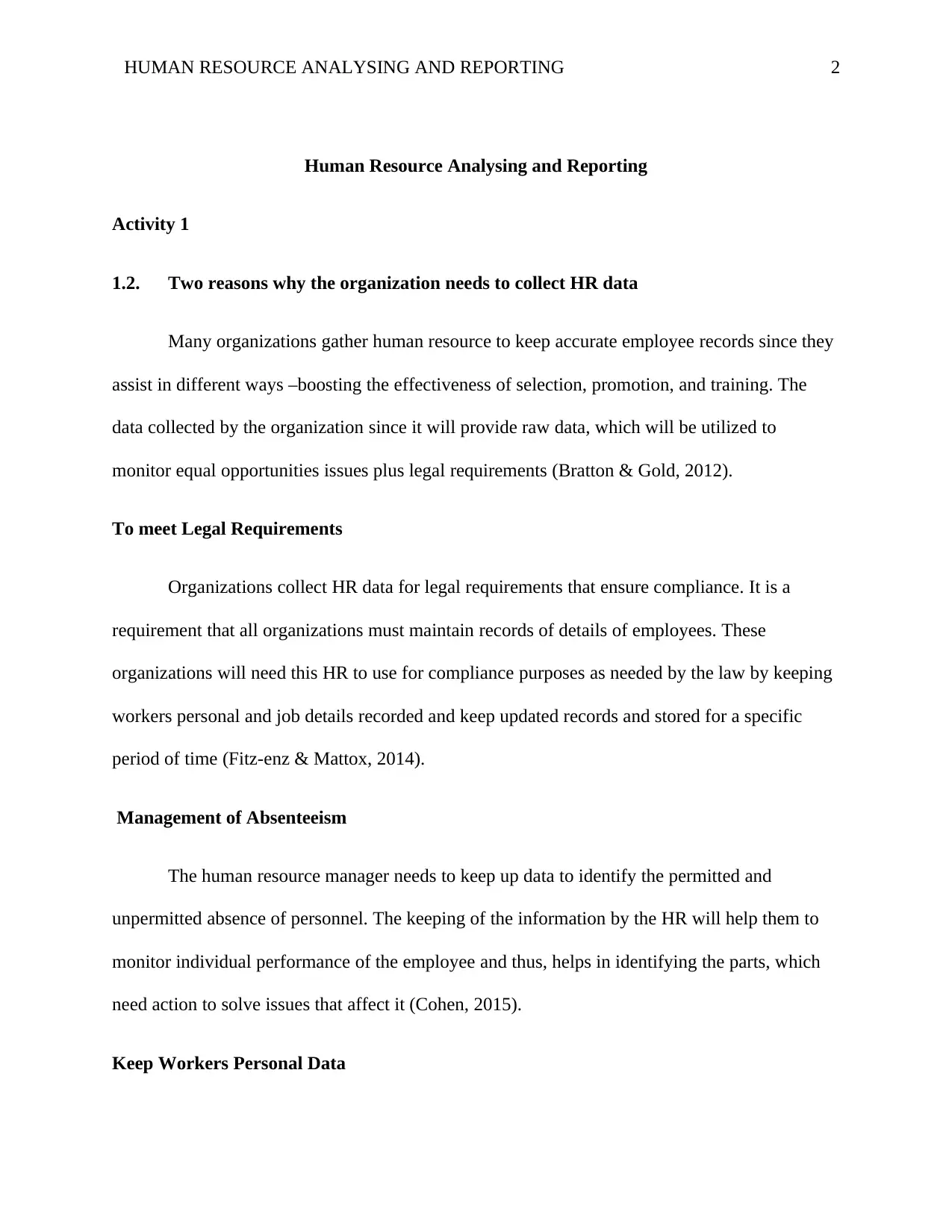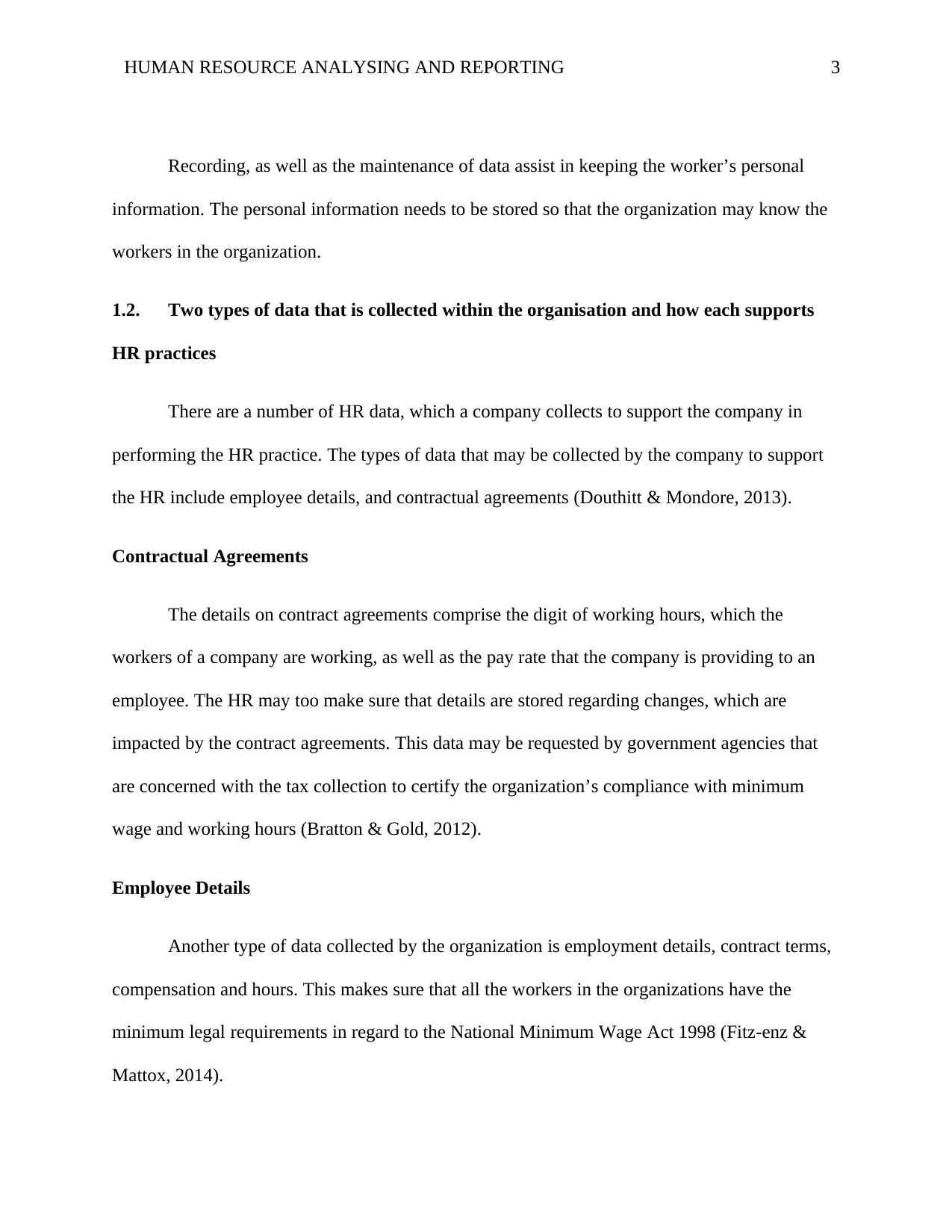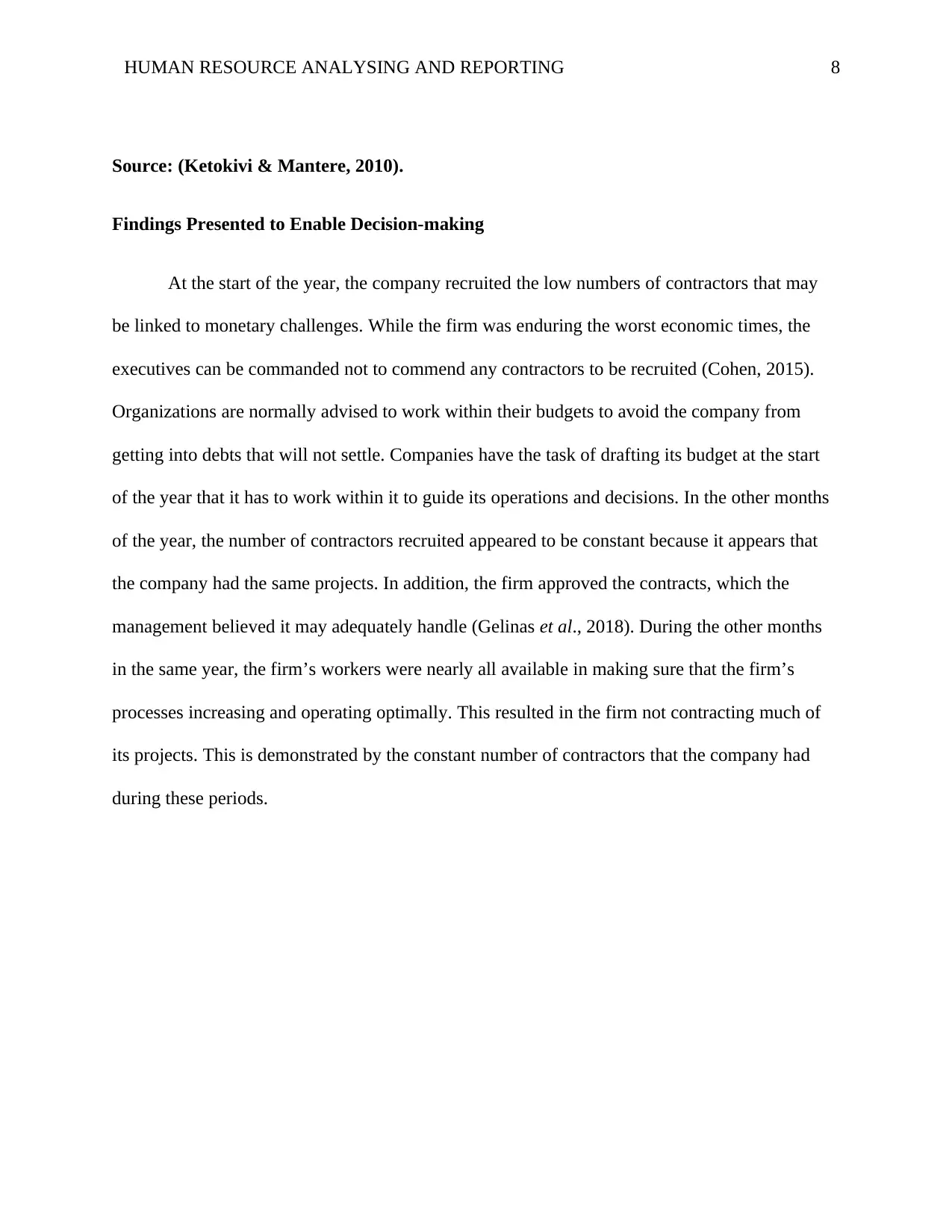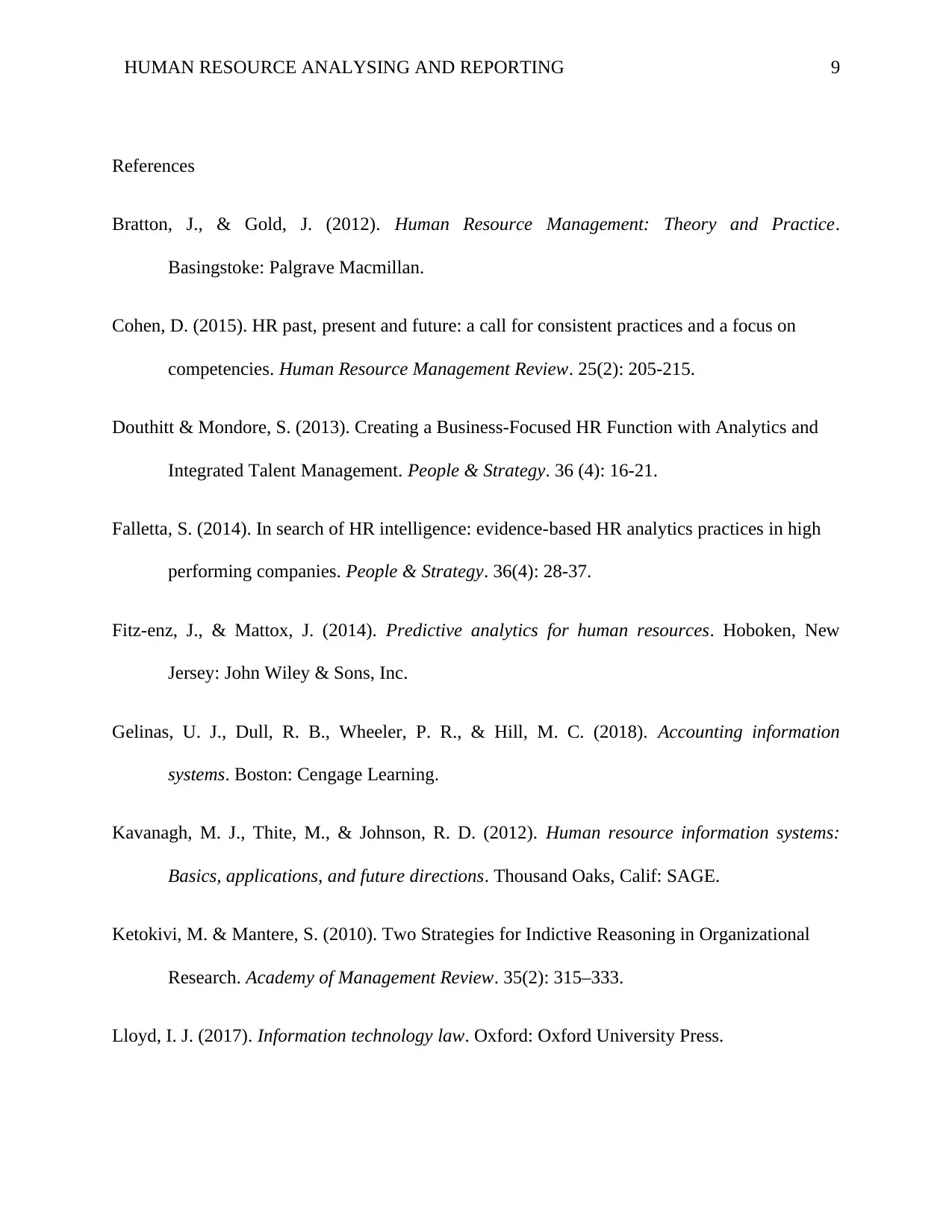3RAI F203A HR Report: HR Data Analysis and Decision Making
VerifiedAdded on 2023/04/22
|10
|1907
|392
Report
AI Summary
This report presents a detailed analysis of human resource (HR) data, addressing key aspects of HR practices. It begins by outlining the reasons why organizations collect HR data, emphasizing the importance of maintaining accurate employee records for selection, promotion, and training, as well as for meeting legal requirements and managing absenteeism. The report then explores different types of HR data, such as employee details and contractual agreements, and explains how each supports HR practices, ensuring compliance with legal standards like the National Minimum Wage Act 1998. Furthermore, the report describes various methods of storing HR records, including electronic and paper files, highlighting the benefits of each, such as instant access and reduced paperwork for electronic files, and no technical issues for paper files. It also examines essential UK legislation related to the recording, storage, and accessibility of HR data, specifically the Data Retention Regulations 2009 and the Data Protection Act. In the second part of the report, an HR area investigated is the quantity of contractual agreements within an organization, analyzing data from January 2018 to December 2018. The findings reveal fluctuations in the number of contractors hired each month, potentially linked to economic challenges and seasonal factors like summer vacations. The report includes a table and a graph visualizing the data and concludes with findings presented to enable decision-making, such as the recommendation for organizations to work within their budgets.

Running Head: HUMAN RESOURCE ANALYSING AND REPORTING
Human Resource Analysing and Reporting
Name
Institution
Date
Human Resource Analysing and Reporting
Name
Institution
Date
Paraphrase This Document
Need a fresh take? Get an instant paraphrase of this document with our AI Paraphraser

HUMAN RESOURCE ANALYSING AND REPORTING 2
Human Resource Analysing and Reporting
Activity 1
1.2. Two reasons why the organization needs to collect HR data
Many organizations gather human resource to keep accurate employee records since they
assist in different ways –boosting the effectiveness of selection, promotion, and training. The
data collected by the organization since it will provide raw data, which will be utilized to
monitor equal opportunities issues plus legal requirements (Bratton & Gold, 2012).
To meet Legal Requirements
Organizations collect HR data for legal requirements that ensure compliance. It is a
requirement that all organizations must maintain records of details of employees. These
organizations will need this HR to use for compliance purposes as needed by the law by keeping
workers personal and job details recorded and keep updated records and stored for a specific
period of time (Fitz-enz & Mattox, 2014).
Management of Absenteeism
The human resource manager needs to keep up data to identify the permitted and
unpermitted absence of personnel. The keeping of the information by the HR will help them to
monitor individual performance of the employee and thus, helps in identifying the parts, which
need action to solve issues that affect it (Cohen, 2015).
Keep Workers Personal Data
Human Resource Analysing and Reporting
Activity 1
1.2. Two reasons why the organization needs to collect HR data
Many organizations gather human resource to keep accurate employee records since they
assist in different ways –boosting the effectiveness of selection, promotion, and training. The
data collected by the organization since it will provide raw data, which will be utilized to
monitor equal opportunities issues plus legal requirements (Bratton & Gold, 2012).
To meet Legal Requirements
Organizations collect HR data for legal requirements that ensure compliance. It is a
requirement that all organizations must maintain records of details of employees. These
organizations will need this HR to use for compliance purposes as needed by the law by keeping
workers personal and job details recorded and keep updated records and stored for a specific
period of time (Fitz-enz & Mattox, 2014).
Management of Absenteeism
The human resource manager needs to keep up data to identify the permitted and
unpermitted absence of personnel. The keeping of the information by the HR will help them to
monitor individual performance of the employee and thus, helps in identifying the parts, which
need action to solve issues that affect it (Cohen, 2015).
Keep Workers Personal Data

HUMAN RESOURCE ANALYSING AND REPORTING 3
Recording, as well as the maintenance of data assist in keeping the worker’s personal
information. The personal information needs to be stored so that the organization may know the
workers in the organization.
1.2. Two types of data that is collected within the organisation and how each supports
HR practices
There are a number of HR data, which a company collects to support the company in
performing the HR practice. The types of data that may be collected by the company to support
the HR include employee details, and contractual agreements (Douthitt & Mondore, 2013).
Contractual Agreements
The details on contract agreements comprise the digit of working hours, which the
workers of a company are working, as well as the pay rate that the company is providing to an
employee. The HR may too make sure that details are stored regarding changes, which are
impacted by the contract agreements. This data may be requested by government agencies that
are concerned with the tax collection to certify the organization’s compliance with minimum
wage and working hours (Bratton & Gold, 2012).
Employee Details
Another type of data collected by the organization is employment details, contract terms,
compensation and hours. This makes sure that all the workers in the organizations have the
minimum legal requirements in regard to the National Minimum Wage Act 1998 (Fitz-enz &
Mattox, 2014).
Recording, as well as the maintenance of data assist in keeping the worker’s personal
information. The personal information needs to be stored so that the organization may know the
workers in the organization.
1.2. Two types of data that is collected within the organisation and how each supports
HR practices
There are a number of HR data, which a company collects to support the company in
performing the HR practice. The types of data that may be collected by the company to support
the HR include employee details, and contractual agreements (Douthitt & Mondore, 2013).
Contractual Agreements
The details on contract agreements comprise the digit of working hours, which the
workers of a company are working, as well as the pay rate that the company is providing to an
employee. The HR may too make sure that details are stored regarding changes, which are
impacted by the contract agreements. This data may be requested by government agencies that
are concerned with the tax collection to certify the organization’s compliance with minimum
wage and working hours (Bratton & Gold, 2012).
Employee Details
Another type of data collected by the organization is employment details, contract terms,
compensation and hours. This makes sure that all the workers in the organizations have the
minimum legal requirements in regard to the National Minimum Wage Act 1998 (Fitz-enz &
Mattox, 2014).
⊘ This is a preview!⊘
Do you want full access?
Subscribe today to unlock all pages.

Trusted by 1+ million students worldwide

HUMAN RESOURCE ANALYSING AND REPORTING 4
2.1. Description of at least two methods of storing records and the benefits of each
Human resource (HR) records include a broad range of data that relates to people
working within a company that can be stored in different media, like electronic files and paper
files.
Electronic files
Every worker in the organization has an individual electronic file that is saved on the
organization’s network drive and backed up each day, especially in the evening. The back-up
system used for electronic files is important because it lowers the potential for permanent loss of
the stored data in the files (Cohen, 2015).
The benefit of storing the data in the electronic files is that there is instant access to the
individual employee data plus it is easier to update data whenever needed. This technique too
lowers the quantity of paperwork that assists Outlook to attain its objective of a paperless office.
In addition, the electronic file also lowers the quantity of office space required to store paper
files and in the event like fire or flood, and electronic system is easier to restore while paper files
cannot be retrieved once lost (Bratton & Gold, 2012).
Paper Files
This means that the files are stored manually. The benefit of storing files in a manual way
is that it will not face technical hitches. Once the data has encountered technical issues it may be
lost.
2.1. Description of at least two methods of storing records and the benefits of each
Human resource (HR) records include a broad range of data that relates to people
working within a company that can be stored in different media, like electronic files and paper
files.
Electronic files
Every worker in the organization has an individual electronic file that is saved on the
organization’s network drive and backed up each day, especially in the evening. The back-up
system used for electronic files is important because it lowers the potential for permanent loss of
the stored data in the files (Cohen, 2015).
The benefit of storing the data in the electronic files is that there is instant access to the
individual employee data plus it is easier to update data whenever needed. This technique too
lowers the quantity of paperwork that assists Outlook to attain its objective of a paperless office.
In addition, the electronic file also lowers the quantity of office space required to store paper
files and in the event like fire or flood, and electronic system is easier to restore while paper files
cannot be retrieved once lost (Bratton & Gold, 2012).
Paper Files
This means that the files are stored manually. The benefit of storing files in a manual way
is that it will not face technical hitches. Once the data has encountered technical issues it may be
lost.
Paraphrase This Document
Need a fresh take? Get an instant paraphrase of this document with our AI Paraphraser

HUMAN RESOURCE ANALYSING AND REPORTING 5
2.2. Two essential items of UK legislation relating to the recording, storage and
accessibility of HR data
The Data Retention Regulations 2009
This regulation asserts that data that contains details of the user internet access, telephone
numbers and email should be retained for a period of one year. This kind of data has IP addresses
assigned to particular organization (Lloyd, 2017).
Data Protection Act
This act is a law that controls and regulates the way individual data or information and
utilized by state and organizations. Thus, any person who makes the decision to use personal
information should comply with the stated regulations and laws regarding the personal
information stored (Lloyd, 2017).
Activity 2
HR Area Investigated
The area of the human resource (HR) data, which I have computed to analyse, is on the
quantity of the contractual agreements, which lead to availing potential contractors aboard to my
current organization that I work for (Falletta, 2014).
Analysis and Interpretation of Data
I made the decision to analyze the statistics, which the contractual agreements, which
were signed along with approved to work on behalf of the organization from January 2018 to
2.2. Two essential items of UK legislation relating to the recording, storage and
accessibility of HR data
The Data Retention Regulations 2009
This regulation asserts that data that contains details of the user internet access, telephone
numbers and email should be retained for a period of one year. This kind of data has IP addresses
assigned to particular organization (Lloyd, 2017).
Data Protection Act
This act is a law that controls and regulates the way individual data or information and
utilized by state and organizations. Thus, any person who makes the decision to use personal
information should comply with the stated regulations and laws regarding the personal
information stored (Lloyd, 2017).
Activity 2
HR Area Investigated
The area of the human resource (HR) data, which I have computed to analyse, is on the
quantity of the contractual agreements, which lead to availing potential contractors aboard to my
current organization that I work for (Falletta, 2014).
Analysis and Interpretation of Data
I made the decision to analyze the statistics, which the contractual agreements, which
were signed along with approved to work on behalf of the organization from January 2018 to

HUMAN RESOURCE ANALYSING AND REPORTING 6
December 2018. The company concurred that its main jobs were to be allocated to the
contractors that meet the requirements of the contract, which were previously established by the
company. Based on the statistics, the company recruited 1,006 contractors for the same time. The
diverse months did not have a similar figure of contractors running the organization’s jobs. In the
business period of the company plus the entire economy should pursue ups and downs; this is a
single ground why the figure of contractors varied in each month (Pease, Byerly & Fitz-enz,
2013).
In the section, the graph that I generated from the contract statistics demonstrates that the
figure of contractors was recruited in August 2018. This may have for the reason that, August
was the month of the year in which the majority of the workers normally go for vacations
because it is summer time. No contractor was hired in September. In addition, another rationale
is that several workers who are on permanent employment terms in the organization would take
annual leave during this time; summer is the most favourable months for these employees to join
their families for vacations and may tour different places across the world to enjoy (Kavanagh,
Thite, & Johnson, 2012). Because the organization would not permit any possible shortage of
employees or any type of delay in its operations, this made the organization to hire contractors to
avoid any delay in its operations and processes. The table 1 below shows the number of
contractors in a given month of the year:
Month
Number Of
Contractors
January 31
December 2018. The company concurred that its main jobs were to be allocated to the
contractors that meet the requirements of the contract, which were previously established by the
company. Based on the statistics, the company recruited 1,006 contractors for the same time. The
diverse months did not have a similar figure of contractors running the organization’s jobs. In the
business period of the company plus the entire economy should pursue ups and downs; this is a
single ground why the figure of contractors varied in each month (Pease, Byerly & Fitz-enz,
2013).
In the section, the graph that I generated from the contract statistics demonstrates that the
figure of contractors was recruited in August 2018. This may have for the reason that, August
was the month of the year in which the majority of the workers normally go for vacations
because it is summer time. No contractor was hired in September. In addition, another rationale
is that several workers who are on permanent employment terms in the organization would take
annual leave during this time; summer is the most favourable months for these employees to join
their families for vacations and may tour different places across the world to enjoy (Kavanagh,
Thite, & Johnson, 2012). Because the organization would not permit any possible shortage of
employees or any type of delay in its operations, this made the organization to hire contractors to
avoid any delay in its operations and processes. The table 1 below shows the number of
contractors in a given month of the year:
Month
Number Of
Contractors
January 31
⊘ This is a preview!⊘
Do you want full access?
Subscribe today to unlock all pages.

Trusted by 1+ million students worldwide

HUMAN RESOURCE ANALYSING AND REPORTING 7
February 89
March 93
April 94
May 90
June 86
July 105
August 147
October 94
November 86
December 91
Source: (Ketokivi & Mantere, 2010).
Graph 1 below provides an analysis of number of contractors in a graphic form:
February 89
March 93
April 94
May 90
June 86
July 105
August 147
October 94
November 86
December 91
Source: (Ketokivi & Mantere, 2010).
Graph 1 below provides an analysis of number of contractors in a graphic form:
Paraphrase This Document
Need a fresh take? Get an instant paraphrase of this document with our AI Paraphraser

HUMAN RESOURCE ANALYSING AND REPORTING 8
Source: (Ketokivi & Mantere, 2010).
Findings Presented to Enable Decision-making
At the start of the year, the company recruited the low numbers of contractors that may
be linked to monetary challenges. While the firm was enduring the worst economic times, the
executives can be commanded not to commend any contractors to be recruited (Cohen, 2015).
Organizations are normally advised to work within their budgets to avoid the company from
getting into debts that will not settle. Companies have the task of drafting its budget at the start
of the year that it has to work within it to guide its operations and decisions. In the other months
of the year, the number of contractors recruited appeared to be constant because it appears that
the company had the same projects. In addition, the firm approved the contracts, which the
management believed it may adequately handle (Gelinas et al., 2018). During the other months
in the same year, the firm’s workers were nearly all available in making sure that the firm’s
processes increasing and operating optimally. This resulted in the firm not contracting much of
its projects. This is demonstrated by the constant number of contractors that the company had
during these periods.
Source: (Ketokivi & Mantere, 2010).
Findings Presented to Enable Decision-making
At the start of the year, the company recruited the low numbers of contractors that may
be linked to monetary challenges. While the firm was enduring the worst economic times, the
executives can be commanded not to commend any contractors to be recruited (Cohen, 2015).
Organizations are normally advised to work within their budgets to avoid the company from
getting into debts that will not settle. Companies have the task of drafting its budget at the start
of the year that it has to work within it to guide its operations and decisions. In the other months
of the year, the number of contractors recruited appeared to be constant because it appears that
the company had the same projects. In addition, the firm approved the contracts, which the
management believed it may adequately handle (Gelinas et al., 2018). During the other months
in the same year, the firm’s workers were nearly all available in making sure that the firm’s
processes increasing and operating optimally. This resulted in the firm not contracting much of
its projects. This is demonstrated by the constant number of contractors that the company had
during these periods.

HUMAN RESOURCE ANALYSING AND REPORTING 9
References
Bratton, J., & Gold, J. (2012). Human Resource Management: Theory and Practice.
Basingstoke: Palgrave Macmillan.
Cohen, D. (2015). HR past, present and future: a call for consistent practices and a focus on
competencies. Human Resource Management Review. 25(2): 205-215.
Douthitt & Mondore, S. (2013). Creating a Business-Focused HR Function with Analytics and
Integrated Talent Management. People & Strategy. 36 (4): 16-21.
Falletta, S. (2014). In search of HR intelligence: evidence-based HR analytics practices in high
performing companies. People & Strategy. 36(4): 28-37.
Fitz-enz, J., & Mattox, J. (2014). Predictive analytics for human resources. Hoboken, New
Jersey: John Wiley & Sons, Inc.
Gelinas, U. J., Dull, R. B., Wheeler, P. R., & Hill, M. C. (2018). Accounting information
systems. Boston: Cengage Learning.
Kavanagh, M. J., Thite, M., & Johnson, R. D. (2012). Human resource information systems:
Basics, applications, and future directions. Thousand Oaks, Calif: SAGE.
Ketokivi, M. & Mantere, S. (2010). Two Strategies for Indictive Reasoning in Organizational
Research. Academy of Management Review. 35(2): 315–333.
Lloyd, I. J. (2017). Information technology law. Oxford: Oxford University Press.
References
Bratton, J., & Gold, J. (2012). Human Resource Management: Theory and Practice.
Basingstoke: Palgrave Macmillan.
Cohen, D. (2015). HR past, present and future: a call for consistent practices and a focus on
competencies. Human Resource Management Review. 25(2): 205-215.
Douthitt & Mondore, S. (2013). Creating a Business-Focused HR Function with Analytics and
Integrated Talent Management. People & Strategy. 36 (4): 16-21.
Falletta, S. (2014). In search of HR intelligence: evidence-based HR analytics practices in high
performing companies. People & Strategy. 36(4): 28-37.
Fitz-enz, J., & Mattox, J. (2014). Predictive analytics for human resources. Hoboken, New
Jersey: John Wiley & Sons, Inc.
Gelinas, U. J., Dull, R. B., Wheeler, P. R., & Hill, M. C. (2018). Accounting information
systems. Boston: Cengage Learning.
Kavanagh, M. J., Thite, M., & Johnson, R. D. (2012). Human resource information systems:
Basics, applications, and future directions. Thousand Oaks, Calif: SAGE.
Ketokivi, M. & Mantere, S. (2010). Two Strategies for Indictive Reasoning in Organizational
Research. Academy of Management Review. 35(2): 315–333.
Lloyd, I. J. (2017). Information technology law. Oxford: Oxford University Press.
⊘ This is a preview!⊘
Do you want full access?
Subscribe today to unlock all pages.

Trusted by 1+ million students worldwide

HUMAN RESOURCE ANALYSING AND REPORTING 10
Pease, G., Byerly, B., & Fitz-enz, J. (2013). Human capital analytics: How to harness the
potential of your organization's greatest asset. Hoboken, N.J. : Wiley.
Pease, G., Byerly, B., & Fitz-enz, J. (2013). Human capital analytics: How to harness the
potential of your organization's greatest asset. Hoboken, N.J. : Wiley.
1 out of 10
Related Documents
Your All-in-One AI-Powered Toolkit for Academic Success.
+13062052269
info@desklib.com
Available 24*7 on WhatsApp / Email
![[object Object]](/_next/static/media/star-bottom.7253800d.svg)
Unlock your academic potential
Copyright © 2020–2025 A2Z Services. All Rights Reserved. Developed and managed by ZUCOL.




